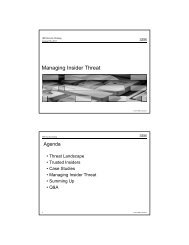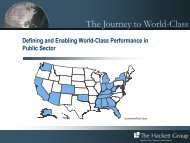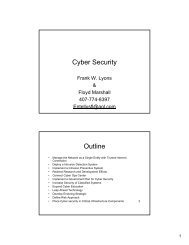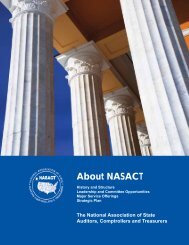The Appropriate Role Of The Internal Revenue Service With Respect To <strong>Tax</strong>-<strong>Exempt</strong> Organizati<strong>on</strong> Good Governance Issuesrequirement. The origin of the specific c<strong>on</strong>cern was that it was not uncomm<strong>on</strong> in the1950s, 1960s <strong>and</strong> 1970s for hospitals to be owned by a small group of communityphysicians; <strong>and</strong> a number of these hospitals came to seek tax exempti<strong>on</strong> but operatedso as to serve the private interests of their founders. 189 Thus, the requirement wasimposed to show that the hospital would be operated for charitable purposes.Over the years, the IRS has imposed additi<strong>on</strong>al governance-type requirements <strong>on</strong>health care organizati<strong>on</strong>s as a c<strong>on</strong>diti<strong>on</strong> of exempti<strong>on</strong>, in each case trying to distinguishthose that not <strong>on</strong>ly promote health but also are organized <strong>and</strong> operated for charitablepurposes from those that serve private purposes. The most comm<strong>on</strong> requirement hasrelated to an independent board. The IRS has been particularly leery of physicianc<strong>on</strong>trolledhealth care organizati<strong>on</strong>s, 190 especially where the physicians determine theirown compensati<strong>on</strong>. 191 Courts, however, have been more lenient in awarding exempti<strong>on</strong>to physician-c<strong>on</strong>trolled practice entities, at least where compensati<strong>on</strong> safeguards are inplace. Thus, the courts have granted exempti<strong>on</strong> to faculty practice plans c<strong>on</strong>trolled byphysicians despite the IRS’s view to the c<strong>on</strong>trary. 192 In the c<strong>on</strong>text of integrateddelivery systems, the IRS has limited physician representati<strong>on</strong> <strong>on</strong> the board of directorsto a stricter 20 percent. 193189See, e.g., Harding Hospital, Inc. v. Comm’r, 505 F.2d 1068 (6 th Cir. 1974); Kenner v. Comm’r, 33 TCM 1239 (1974); S<strong>on</strong>oraCommunity Hosp. v. Comm’r, 397 F.2d 814 (9 th Cir. 1968) (mem.), aff’g 46 TC 519 (1966); Lowry Hospital Ass’n v. Comm’r, 66 TC850 (1976); Maynard Hosp., Inc. v. Comm’r, 52 TC 1006 (1969). See also the n<strong>on</strong>-qualifying hospital example in Rev. Rul. 69-545,1969-2 C.B. 117.190In fact, there have been practiti<strong>on</strong>ers who encouraged for-profit physician groups to c<strong>on</strong>sider tax exempti<strong>on</strong> for their grouppractices. See, e.g., K<strong>on</strong>rad Friedmann, <strong>Tax</strong> <strong>Exempt</strong> Status for Medical Clinics: A Complex, Rewarding Opti<strong>on</strong>, HealthSpan,July/August 1990, at 11 reprinted in 3 <strong>Exempt</strong> Org. <strong>Tax</strong> Rev. 1233 (1991).191See, e.g., Rev. Rul. 69-266, 1969-1 C.B. 151 (clinic created <strong>and</strong> c<strong>on</strong>trolled by physicians not exempt as does not differsignificantly from private practice of medicine for profit); Lorain Ave. Clinic v. Comm’r, 31 TC 141 (1958); Fort Scott Clinic <strong>and</strong> Hosp.,Corp. v. Broderick, 99 F. Supp. 515 (D. Kan. 1951); Labrenz Found. v. Comm’r, 33 TCM 1374 (1974).192See, e.g., the three initial cases involving academic physician practice plans: B.H.W. Anesthesia Found., Inc. v. Comm’r, 72 TC681 (1979), n<strong>on</strong>acq., 1980-2 CB 2; University of Mass. Medical School Group Practice v. Comm’r, 74 TC 1299 (1980), acq., 1980-2C.B. 2; University of Md. Physicians, P.A. v. Comm’r, 41 TCM 732 (1981). See also, Akr<strong>on</strong> Clinic Found. v U.S., 64-1 USTC 9233(ND Ohio 1964)(clinic).193In the early 1990s, the IRS was c<strong>on</strong>fr<strong>on</strong>ted with the establishment of integrated delivery systems that included the creati<strong>on</strong> ofnetworks comprised of <strong>on</strong>e or more hospitals <strong>and</strong> <strong>on</strong>e or more groups of employed or captive physicians. Ultimately, the IRS ruledfavorably but it took the aggressive step of limiting physician c<strong>on</strong>trol of the combined entity to 20 percent of the board. See, e.g.,Charles F. Kaiser & T.J. Sullivan, Integrated Delivery Systems <strong>and</strong> Health Care Update, <strong>Exempt</strong> Org. C<strong>on</strong>tinuing Prof. Educ. Tech.Instructi<strong>on</strong> Program for FY 1996 384; Charles F. Kaiser et al., Integrated Delivery Systems <strong>and</strong> Joint Venture Dissoluti<strong>on</strong>s Update,<strong>Exempt</strong> Org. C<strong>on</strong>tinuing Prof. Educ. Tech. Instructi<strong>on</strong> Program for FY 1995 153; Charles F. Kaiser & John Francis Reilly, IntegratedDelivery Systems, <strong>Exempt</strong> Org. C<strong>on</strong>tinuing Prof. Educ. Tech. Instructi<strong>on</strong> Program for FY 1994 212; IRS Officials Alert Hospitals toCurrent C<strong>on</strong>cerns, 7 <strong>Exempt</strong> Org. <strong>Tax</strong> Rev. 713 (1993). For a short period, the IRS included all financially interested pers<strong>on</strong>s withinits 20 percent maximum,( Rockford Memorial Health Services Corp. of Rockford, Illinois. See, e.g., Paul Streckfus, Another IDSRuling Released by IRS Nati<strong>on</strong>al Office, 9 <strong>Exempt</strong> Org. <strong>Tax</strong> Rev. 992 (1994); Integrated Delivery System, System Joining Clinic,Hospital, Managed Care <strong>Entities</strong> Wins <strong>Exempt</strong>i<strong>on</strong>, 3 Health L. Rep. (BNA) 498 (1994), although it later relented, including within the20 percent <strong>on</strong>ly physicians selling assets to, or providing professi<strong>on</strong>al services in c<strong>on</strong>juncti<strong>on</strong> with, the integrated delivery system<strong>and</strong> characterizing the 20 percent limit as a “safe harbor” applicable to organizati<strong>on</strong>s without a track record. See, e.g., Charles F.Kaiser & T.J. Sullivan, Integrated Delivery Systems <strong>and</strong> Health Care Update, <strong>Exempt</strong> Org. C<strong>on</strong>tinuing Prof. Educ. Tech. Instructi<strong>on</strong>Program for FY 1996 384, 390-91. In <strong>on</strong>e case that may be aberrati<strong>on</strong>al, the IRS applied the 20 percent limitati<strong>on</strong> to a for-profitphysician hospital organizati<strong>on</strong> (PHO). See Participati<strong>on</strong> in PHO Will Not Jeopardize <strong>Tax</strong>-<strong>Exempt</strong> Status, 10 <strong>Exempt</strong> Org. <strong>Tax</strong> Rev.1323 (1994); Burda, “IRS Gives Nod to PHO, But Physicians Say No,” Modern Healthcare 3 (Oct. 24, 1994); 4 Health L. Rep. (BNA)151 (1995).ADVISORY COMMITTEE ON TAX EXEMPT AND GOVERNMENT ENTITIES (<strong>ACT</strong>) June 11, 2008 86
The Appropriate Role Of The Internal Revenue Service With Respect To <strong>Tax</strong>-<strong>Exempt</strong> Organizati<strong>on</strong> Good Governance IssuesThe IRS also tightened the c<strong>on</strong>trol requirements for joint ventures between exempthospitals <strong>and</strong> for-profit pers<strong>on</strong>s. 194 In Revenue Ruling 98-15, 195 the IRS c<strong>on</strong>sideredwhether a tax-exempt entity that operated a hospital jeopardized its exempti<strong>on</strong> when ittransferred its hospital assets into a joint venture entity owned equally by it <strong>and</strong> by a forprofitentity (known as a “whole hospital” joint venture). In the “good” fact pattern theexempt entity maintained governance c<strong>on</strong>trol over the joint venture entity (the exemptentity chose a majority of the joint venture governing board <strong>and</strong> each of those boardmembers were independent community leaders); maintained c<strong>on</strong>trol over the day-todayoperati<strong>on</strong>s of the joint venture entity; c<strong>on</strong>flicts of interest were minimized (theofficers, directors <strong>and</strong> key employees of the hospital were independent of the for-profitentity <strong>and</strong> n<strong>on</strong>e of the hospital officers, directors or key employees involved in thedecisi<strong>on</strong> to form the joint venture was promised employment or offered otherinducements); <strong>and</strong> safeguards were in place intended to assure that the joint venturewould operate to further charitable purposes <strong>and</strong> not just to maximize profits. Byc<strong>on</strong>trast, in the “bad” fact pattern, the IRS found that the hospital failed to establish itwould be operated exclusively for exempt purposes, <strong>and</strong> therefore no l<strong>on</strong>ger qualifiedfor exempti<strong>on</strong>, where the hospital chose <strong>on</strong>ly half of the governing board members(each of whom was an independent community leader); the chief executive officer <strong>and</strong>chief financial officer for the joint venture previously work for the for-profit entity; the jointventure engaged a subsidiary of the for-profit entity to serve as manager pursuant to ac<strong>on</strong>tract that could be renewed indefinitely at the manager’s discreti<strong>on</strong>; <strong>and</strong> there wereno assurances that the joint venture would serve charitable purposes over maximizingprofits .In Revenue Ruling 2004-51, 196 the IRS set a somewhat more relaxed c<strong>on</strong>trol st<strong>and</strong>ardin the c<strong>on</strong>text of an “ancillary” joint venture (i.e., a joint venture that is not a substantialpart of the exempt entity’s charitable activities). In this ruling, a university entered into a50-50 joint venture with a for-profit entity specializing in c<strong>on</strong>ducting interactive videotraining programs limited to offer teaching training seminars at off-campus locati<strong>on</strong>susing interactive video technology. The IRS found that the university was engaged inan activity substantially related to its exempt purposes, <strong>and</strong> the inurement <strong>and</strong> privatebenefit prohibiti<strong>on</strong>s were not implicated where the exempt organizati<strong>on</strong> <strong>and</strong> for-profitentity each appointed half of the joint venture governing board. Safeguards showingsufficient c<strong>on</strong>trol by the university to ensure that the joint venture operates for its exempt194For a general discussi<strong>on</strong> about IRS’s evolving view <strong>on</strong> joint ventures between tax-exempt <strong>and</strong> for-profit entities, see, e.g.,MICHAEL I. SANDERS, JOINT VENTURES INVOLVING TAX-EXEMPT ORGANIZATIONS (2007); McDermott Will & Emery IRS Revenue RulingApproves <strong>Tax</strong>-<strong>Exempt</strong> Organizati<strong>on</strong> Participati<strong>on</strong> in Ancillary Joint Ventures,”http://www.mwe.com/index.cfm/fuseacti<strong>on</strong>/publicati<strong>on</strong>s.nldetail/object_id/6f1f3160-b371-4660-9e2f-eda902fd1494.cfm (May 13,2004).195Rev. Rul. 98-15, 1998-1 C.B. 718. See also Redl<strong>and</strong>s Surgical Services v. Commissi<strong>on</strong>er, 113 T.C. 47 (1999), aff’d per curiam,242 F. 3d 904 (9th Cir. 2001), finding that participati<strong>on</strong> in an ambulatory surgical center joint venture did not qualify for exempti<strong>on</strong>because c<strong>on</strong>trol by the for-profit venture partners c<strong>on</strong>stituted substantial private benefit; St. David’s Health Care System, Inc. v.United States, 2002-1 USTC 50,452 (W.D. Tex. 2002), rev’d <strong>and</strong> rem<strong>and</strong>ed, 349 F.3d. 232 (5th Cir. 2003), St. David’s Health CareSystem v. United States of America, Civil Acti<strong>on</strong> No. A-01-CA-46 JN, reported at 2004 TNT 46-4, (W.D. Tex), where a federaldistrict court jury ultimately determined that the exempt entity had maintained sufficient c<strong>on</strong>trol over the whole hospital joint venturewith a for-profit hospital company to assure that the joint venture was operated for charitable purposes, despite the Fifth Circuit’ssuggesti<strong>on</strong> that it would be difficult to make such a determinati<strong>on</strong>.196Rev. Rul. 2004-51, 2004-1 C.B. 974.ADVISORY COMMITTEE ON TAX EXEMPT AND GOVERNMENT ENTITIES (<strong>ACT</strong>) June 11, 2008 87













